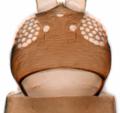Stomatothrips flavus
Recognition data
Distinguishing features
Both sexes fully winged or short winged. Female strongly bicolored, body largely brown but abdominal segment II yellow, III commonly yellow at least on posterior half, I sometimes yellow; all tibiae and tarsi brown, femora usually yellow at base; antennal segments V–IX brown, I–IV yellow with IV often dark at apex; fore wing banded, brown with transverse clear area sub-basally and sub-apically, but often slightly paler medially. Antennae 9-segmented, VII–IX forming a unit with VII 2.0 to 2.5 times as long as VIII, sensoria on III–IV linear with internal markings. Head and pronotum with no long setae, eyes strongly extended posteriorly on ventral surface of head. Mesonotum transversely striate, with many setae medially. Metanotum typical of genus, transversely striate/reticulate on anterior half, reticulate on posterior, median pair of setae near posterior margin. Fore wing wider distally than near base. Abdominal tergites with weak sculpture, tergite X with pair of small trichobothria; sternites III–VI with transverse row of discal setae medially, four pairs of posteromarginal setae although lateral two pairs arise on disc.
Related and similar species
There are eight species listed in the genus Stomatothrips, but two of these from North America (S. brunneus from Arkansas and S. crawfordi from Illinois) are at present not distinguished satisfactorily from S. flavus. Of the other five species, one is known only from Texas, two from Brazil, and one each from Argentina and Trinidad.
Taxonomic data
Current valid name
Stomatothrips flavus Hood
Original name and synonyms
- Stomatothrips flavus Hood, 1912: 64
Family placement
Aeolothripidae
Biological data
Life history
Presumably predatory on other small arthropods.
Host plants
Living at the base of various grasses.
Tospoviruses vectored
None
Crop damage
None
Distribution data
Area of origin
Western North America
Distribution
Described from Mexico, the distribution of this species in North America will remain unclear until the significance of the two species described from Arkansas and Illinois is made clearer. Currently it seems that S. flavus is widespread across the USA, from Virginia and Georgia, through Utah and Arizona into California and Mexico (Bailey, 1952). Given such a wide range, it is possible that a morphological cline might exist across the continent.









